Categories
Archives
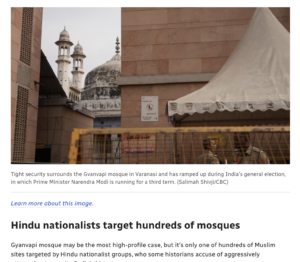
A few months in, things are going very well for the IPTC’s new Media Provenance Committee.
The IPTC Committee was initiated to continue the work started by Project Origin to bring the benefits of C2PA provenance technology to the news media industry. The Committee is chaired by Bruce MacCormack of CBC / Radio Canada.
The Committee has initiated three Working Groups who will be looking at specific issues:
- The Provenance Governance Working Group, led by Charlie Halford of the BBC.
- The Provenance Best Practices and Implementation Working Group, led by Helge O. Svela of Media City Bergen.
- The Provenance Advocacy and Education Working Group, led by Judy Parnall of the BBC.
We have also started the process of onboarding participants for the next phase of the Origin Verified News Publishers List, and have had several organisations already apply.
The first publishers on the list, BBC and CBC/Radio Canada, have already published some C2PA-signed content:
- The BBC has published some images and video with C2PA-embedded metadata showing the fact-checking process that has been undertaken by the BBC Verify fact-checking team.
- CBC / Radio Canada has published images signed with the CBC certificate on the cbc.ca website.
We are planning several events in the future to promote our work and encourage more in the media industry to get involved. Look out for news about IPTC Media Provenance work at the IBC Conference in Amsterdam in September and at other events.
If your organisation would like to be added to the list in the next phase or in the future, please get in touch!
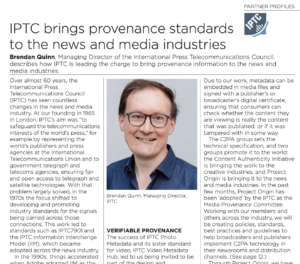
The IPTC’s Managing Director, Brendan Quinn, has written an article for the latest edition of the European Broadcasting Union’s technical magazine, EBU tech-i.
In the article, Brendan promotes the IPTC’s work in Media Provenance, including the founding of the IPTC Media Provenance Committee.
Brendan’s article can be found on page 17 of the PDF or print copy or the magazine.
The issue also contains a piece by Judy Parnall of the BBC, current Chair of the Committee, also covering C2PA and our joint work on media provenance.
The issue also contains interesting insights from European broadcasters on AI in media production, innovating to meet the challenges of covering the Paris 2024 Olympics, the creation of an Enterprise Architecture working group within the EBU membership, cybersecurity for media outlets, the future of broadcast radio in a world connected cars, and more.

Media consultant and IPTC Individual Member Denise Durand Kremer gave a presentation on IPTC Photo Metadata at the Seminário Fototeca Brasileira – the Brazilian Photo Library Seminar.
Over three days, more than 80 people got together to discuss the idea of a national photo library for Brazil. Denise was invited by the Collection and Market group Acervo e Mercado to talk about her experience as an iconographic researcher and about the IPTC standard for photographic metadata.
Photographers, teachers, researchers, archivists and public managers from institutions such as the Museu da Imagem e do Som de São Paulo – MIS (Museum of Image and Sound of São Paulo), Funarte, Instituto Moreira Salles, Zumví and Arquivo Afro Fotográfico participated in the event.
The meeting ended with a commitment from the Executive Secretary of the Ministry of Culture, to set up a working group to take the idea forward.
The seminar was recorded and will be available on SescTV.
Update, 6 August 2024: The video has now been released publicly. You can view Denise’s section below (in Brazilian Portuguese):
Thanks very much Denise for spreading the word about IPTC standards in Brazil!
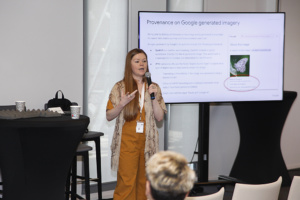
Last week CEPIC, the “centre of the picture industry”, held its annual Congress in Juan-les-Pins in France. This was the second time that the event was held at the Palais du Congres in Juan-les-Pins near Antibes, which is proving to be a great venue for the Congress with many repeat visitors who also attended last year.
IPTC was well represented at the event, with Managing Director Brendan Quinn presenting on two panels and many other IPTC members involved in presentations, panels or simply attending the event. IPTC members either presenting or in attendance included Google, Shutterstock, Getty Images, ANSA, IMATAG, PA Media / Alamy, TT, dpa, Adobe, Xinhua, Activo, APA, European Pressphoto Agency EPA and possibly more that we have missed!

One of the highlights for us was the Provenance and AI panel moderated by Anna Dickson, who until recently was with Google but is now with another IPTC member, Shutterstock. Presenters on this panel included Katharina Familia Almonte, product manager at Google, Andy Parsons, Director of the Content Authenticity Initiative (although Brendan ended up presenting his slides due to it being 4.30am for Andy in New York at the time!); Mathieu Desoubeaux, CEO of IPTC startup member IMATAG, and Brendan Quinn, Managing Director of IPTC.
Brendan used the opportunity to introduce the IPTC Media Provenance Committee and the work that the IPTC is doing on creating a C2PA Trust List for media organisations. Brendan put out a call for other media organisations who may be interested in joining the next cohort of certificate holders who will be able to obtain a certificate stored on the trust list and use it to cryptographically sign their media content. The discussion went on to look at the issues around using both C2PA and watermarking technology to protect image content.
Later in the day was the panel “Where Law and Technology Meet.” Moderated by Lars Modie (CEPIC, previously of IBL Bildbyrå / TT in Swededn) with speakers: Serguei Fomin (IQPlug, IPTC CEPIC representative), Brendan Quinn (IPTC), Franck Bardol (University of Geneva), Nancy Wolff (partner at the intellectual property, media and entertainment law firm of Cowan, DeBaets, Abrahams & Sheppard, LLP and DMLA counsel) and Katherine Briggs of Australian agency Envato which was recently acquired by Shutterstock.

At this panel, Brendan outlined IPTC’s recent guidance on metadata for generative AI images. This includes the Digital Source Type property but also guidance on using the Creator, Contributor, and Data Mining properties to signal ownership and rights licensing information associated with images, particularly for engines that “scrape” web content to train generative AI models.
Many stimulating conversations always make the CEPIC Congress a valuable event for us to attend, and we are already looking forward to next year’s instalment.
Tuesday’s IPTC Photo Metadata Conference was a great success. With 12 speakers from the media and software industries and over 200 people registered, it continues to be the largest gathering of photo and image metadata experts globally.
Introduction and welcome, 20 years of IPTC Photo Metadata, Recent work on Photo Metadata at IPTC
We started off with David Riecks and Michael Steidl, co-leads of the IPTC Photo Metadata Working Group, giving an update on what the IPTC has been working on in the areas of photo metadata since the last conference in 2022, along with Brendan Quinn, IPTC Managing Director.
A lot has been happening, including Meta announcing support for IPTC metadata for Generative AI, launching the IPTC Media Provenance Committee and updating the IPTC Photo Metadata User Guide, including our guidance for how to tag Generative AI content with metadata and how to use the DigitalSourceType field.
Panel 1: AI and Image Authenticity
The first panel saw Leonard Rosenthol of Adobe, Lead of the C2PA Technical Working Group; Dennis Walker of Camera Bits, creators of Photo Mechanic; Dr. Neal Krawetz, Computer security specialist, forensic researcher, and founder of FotoForensics; and Bofu Chen, Founder & CTO of Numbers Protocol speak about image provenance and authenticity, covering the C2PA spec, the problems of fraudulent images, what it’s like to implement C2PA technology in existing software, and how blockchain-based systems could be built on top of C2PA to potentially extend its capabilities.
Session on Adobe’s Custom Metadata Panel
James Lockman, Group Manager, Digital Media Services at Adobe demonstrated the Custom Metadata Panel plugin for some Adobe tools (Bridge, Illustrator, Photoshop and Premiere Pro) that allows the full range of IPTC Photo Metadata Standard and IPTC Video Metadata Hub, or any other metadata schema, to be edited directly in Adobe’s interface.
Panel 2: AI-powered asset management
Speakers Nancy Wolff, Partner at Cowan, DeBaets, Abrahams & Sheppard, LLP; Serguei Fomine, Founder and CEO of IQPlug; Jeff Nova, Chief Executive Officer at Colorhythm and Mark Milstein, co-founder and Director of Business Development at vAIsual discussed the impact of AI on copyright, metadata and media asset management.
The full event recording is also available as a YouTube playlist.
Thanks to everyone for coming and especial thanks to our speakers. We’re already looking forward to next year!
The IPTC News Architecture Working Group is happy to announce the release of NewsML-G2 version 2.34.
This version, approved at the IPTC Standards Committee Meeting at the New York Times offices on Wednesday 17th April 2024, contains one small change and one additional feature:
Change Request 218, increase nesting of <related> tags: this allows for <related> items to contain child <related> items, up to three levels of nesting. This can be applied to many NewsML-G2 elements:
- pubHistory/published
- QualRelPropType (used in itemClass, action)
- schemeMeta
- ConceptRelationshipsGroup (used in concept, event, Flex1PropType, Flex1RolePropType, FlexPersonPropType, FlexOrganisationPropType, FlexGeoAreaPropType, FlexPOIPropType, FlexPartyPropType, FlexLocationPropType)
Note that we chose not to allow for recursive nesting because this caused problems with some XML code generators and XML editors.
Change Request 219, add dataMining element to rightsinfo: In accordance with other IPTC standards such as the IPTC Photo Metadata Standard and Video Metadata Hub, we have now added a new element to the <rightsInfo> block to convey a content owner’s wishes in terms of data mining of the content. We recommend the use of the PLUS Vocabulary that is also recommended for the other IPTC standards: https://ns.useplus.org/LDF/ldf-XMPSpecification#DataMining
Here are some examples of its use:
Denying all Generative AI / Machine Learning training using this content:
<rightsInfo> <dataMining uri="http://ns.useplus.org/ldf/vocab/DMI-PROHIBITED-AIMLTRAINING"/> </rightsInfo>
A simple text-based constraint:
<rightsInfo> <usageTerms> Data mining allowed for academic and research purposes only. </usageTerms> <dataMining uri="http://ns.useplus.org/ldf/vocab/DMI-PROHIBITED-SEECONSTRAINT" /> </rightsInfo>
A simple text based constraint, expressed using a QCode instead of a URI:
<rightsInfo> <usageTerms> Reprint rights excluded. </usageTerms> <dataMining qcode="plusvocab:DMI-PROHIBITED-SEECONSTRAINT" /> </rightsInfo>
A text-based constraint expressed in both English and French:
<rightsInfo> <usageTerms xml:lang="en"> Reprint rights excluded. </usageTerms> <usageTerms xml:lang="fr"> droits de réimpression exclus </usageTerms> <dataMining uri="http://ns.useplus.org/ldf/vocab/DMI-PROHIBITED-SEECONSTRAINT" /> </rightsInfo>
Using the “see embedded rights expression” constraint to express a complex machine-readable rights expression in RightsML:
<rightsInfo>
<rightsExpressionXML langid="http://www.w3.org/ns/odrl/2/">
<!-- RightsML goes here... -->
</rightsExpressionXML>
<dataMining uri="http://ns.useplus.org/ldf/vocab/DMI-PROHIBITED-SEEEMBEDDEDRIGHTSEXPR"/>>
</rightsInfo>
For more information, contact the IPTC News Architecture Working Group via the public NewsML-G2 mailing list.
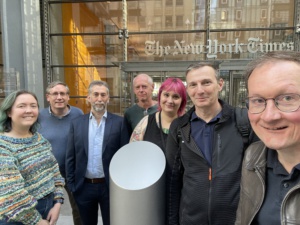
Last week, the IPTC Spring Meeting 2024 brought media industry experts together for three days in New York City to discuss many topics including AI, archives and authenticity.
Hosted by both The New York Times and Associated Press, over 50 attendees from 14 countries participated in person, with another 30+ delegates attending online.
As usual, the IPTC Working Group leads presented a summary of their most recent work, including a new release of NewsML-G2 (version 2.34, which will be released very soon); forthcoming work on ninjs to support events, planned news coverage and live streamed video; updates to NewsCodes vocabularies; more evangelism of IPTC Sport Schema; and further work on Video Metadata Hub, the IPTC Photo Metadata Standard and our emerging framework for a simple way to express common rights statements using RightsML.
We were very happy to hear many IPTC member organisations presenting at the Spring Meeting. We heard from:
- Anna Dickson of recently-joined member Google talked about their work with IPTC in the past and discussed areas where we could collaborate in the future
- Aimee Rinehart of Associated Press presented AP’s recent report on the use of generative AI in local news
- Scott Yates of JournalList gave an update on the trust.txt protocol
- Andreas Mauczka, Chief Digital Officer at Austria Press Agency APA presented on APA’s framework for use of generative AI in their newsroom
- Drew Wanczowski of Progress Software gave a demonstration of how IPTC standards can be implemented in Progress’s tools such as Semaphore and MarkLogic
- Vincent Nibart and Geert Meulenbelt of new IPTC Startup Member Kairntech presented on their recent work with AFP on news categorisation using IPTC Media Topics and other vocabularies
- Mathieu Desoubeaux of IPTC Startup Member IMATAG presented their work, also with AFP, on watermarking images for tracking and metadata retrieval purposes
In addition we heard from guest speakers:
- Jim Duran of the Vanderbilt TV News Archive spoke about how they are using AI to catalog and tag their extensive archive of decades of broadcast news content
- John Levitt of Elvex spoke about their system which allows media organisations to present a common interface (web interface and developer API) to multiple generative AI models, including tracking, logging, cost monitoring, permissions and other governance features which are important to large organisations using AI models.
- Toshit Panigrahi, co-founder of TollBit spoke about their platform for “AI content licensing at scale”, allowing content owners to establish rules and monitoring around how their content should be licensed for both the training of AI models and for retrieval-augmented generation (RAG)-style on-demand content access by AI agents.
- We also heard an update about the TEMS – Trusted European Media Data Space project.
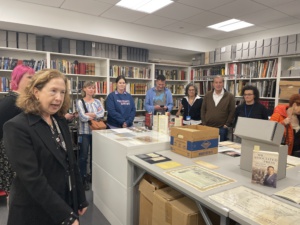 We were also lucky enough to take tours of the Associated Press Corporate Archive on Tuesday and the New York Times archive on Wednesday. Valierie Komor of AP Corporate Archives and Jeff Roth of The New York Times Archival Library (known to staffers as “the morgue”) both gave fascinating insights and stories about how both archives preserve the legacy of these historically important news organisations.
We were also lucky enough to take tours of the Associated Press Corporate Archive on Tuesday and the New York Times archive on Wednesday. Valierie Komor of AP Corporate Archives and Jeff Roth of The New York Times Archival Library (known to staffers as “the morgue”) both gave fascinating insights and stories about how both archives preserve the legacy of these historically important news organisations.
Brendan Quinn, speaking for Judy Parnall of the BBC, also presented an update of the recent work of C2PA and Project Origin and introduced the new IPTC Media Provenance Committee, dedicated to bringing C2PA technology to the news and media industry.
On behalf all attendees, we would like to thank The New York Times and Associated Press for hosting us, and especially to thank Jennifer Parrucci of The New York Times and Heather Edwards of The Associated Press for their hard work in coordinating use of their venues for our meeting.
The next IPTC Member Meeting will be the 2024 Autumn Meeting, which will be held online from Monday September 30th to Wednesday October 2nd, and will include the 2024 IPTC Annual General Meeting. The Spring Meeting 2025 will be held in Western Europe at a location still to be determined.

The International Press Telecommunications Council, in conjunction with Project Origin, has established a working group to create and manage a C2PA compatible list of verified news publishers.
The open C2PA 2.0 Content Credentials standard for media provenance is widely supported as a strong defence against misinformation. Recent announcements by OpenAI, Meta, Google and others have confirmed the value of an interoperable, tamper-evident way of confirming the source and technical integrity of digital media content.
Project Origin, as a co-founder of the C2PA, has brought the needs of the news publishing community to the forefront of the creation of this standard. This now includes the creation of a C2PA 2.0 compatible Origin Verified Publisher Certificate to be used by publishers to securely create a cryptographic seal on their content. The signing certificates will be available through the IPTC, who will work with C2PA validators to gain widespread acceptance. These signing certificates will be issued by the IPTC to broadcast, print and digital native media publishers.
Origin Verified Publisher Certificates will ensure that the identity of established news organisations are protected from imposters. The certificates confirm organisational identity and do not make any judgement on editorial position. Liaison agreements with other groups in the media ecosystem will be used to accelerate the distribution of certificates.
The initial implementation uses TruePic as a certificate authority, with the BBC and CBC/Radio-Canada as trial participants.
“As a founding partner of Project Origin, CBC/Radio-Canada is proud to be one of the first media organisations to trial Origin Verified Publisher Certificates,” said Claude Galipeau, Executive Vice-President, Corporate Development, CBC/Radio-Canada. “This initiative will provide our audiences with a new and easy way of confirming that the content they’re consuming is legitimately from Canada’s national public broadcaster. It’s an important step in our adoption of the Content Credentials standard and in our fight against misinformation and disinformation.”
Jatin Aythora, Director of BBC R&D, and vice chair for Partnership on AI, said “Media provenance increases trust and transparency in news, and so is an essential tool in the fight against disinformation. That fight has never been more important, and so we hope many more media organisations will join us in securing their own Origin Verified Publisher Certificate.”
Publishers interested in working cooperatively to advance the implementation of the C2PA standard in the news ecosystem are invited to join the Media Provenance Committee of the IPTC.
For further information please contact:
- Judy Parnall – judy.parnall@bbc.co.uk – representing the BBC
- Bruce MacCormack – bruce@neuraltransform.com – representing CBC/Radio-Canada
- Brendan Quinn – mdirector@iptc.org – representing the IPTC
The 2024 IPTC Photo Metadata Conference takes place as a webinar on Tuesday 7th May from 1500 – 1800 UTC. Speakers hail from Adobe (makers of Photoshop), CameraBits (makers of PhotoMechanic), Numbers Protocol, Colorhythm, vAIsual and more.
First off, IPTC Photo Metadata Working Group co-leads, David Riecks and Michael Steidl, will give an overview of what has been happening in the world of photo metadata since our last Conference in November 2022, including IPTC’s work on metadata for AI labelling, “do not train” signals, provenance, diversity and accessibility.
Next, a panel session on AI and Image Authenticity: Bringing trust back to photography? discusses approaches to the problem of verifying trust and credibility for online images. The panel features C2PA lead architect Leonard Rosenthol (Adobe), Dennis Walker (Camera Bits), Neal Krawetz (FotoForensics) and Bofu Chen (Numbers Protocol).
Next, James Lockman of Adobe presents the Custom Metadata Panel, which is a plugin for Photoshop, Premiere Pro and Bridge that allows for any XMP-based metadata schema to be used – including IPTC Photo Metadata and IPTC Video Metadata Hub. James will give a demo and talk about future ideas for the tool.
Finally, a panel on AI-Powered Asset Management: Where does metadata fit in? discusses teh relevance of metadata in digital asset management systems in an age of AI. Speakers include Nancy Wolff (Cowan, DeBaets, Abrahams & Sheppard, LLP), Serguei Fomine (IQPlug), Jeff Nova (Colorhythm) and Mark Milstein (vAIsual).
The full agenda and links to register for the event are available at https://iptc.org/events/photo-metadata-conference-2024/
Registration is free and open to anyone who is interested.
See you there on Tuesday 7th May!
The IPTC Photo Metadata Working Group has updated the IPTC Photo Metadata User Guide, including guidance for accessibility and for tagging AI-generated images with metadata.
The updates to the User Guide are across several areas:
- A guide to using the accessibility fields added in IPTC Photo Metadata Standard version 2021.1 (Alt Text (Accessibility) and Extended Description (Accessibility) has been added
-
A new section with guidance for applying metadata to AI-generated images has been added
-
Guides for new fields added: Event Identifier, Product/Identifier, Contributor, Data Mining
-
The Metadata Usage Examples section has been updated to reflect some of the recently-added fields
-
The guidance on fields and topics has generally been reviewed and updated
Please let us know if you spot any other areas of the user guide that should be updated or if you have suggestions for more guidance that we could give.
